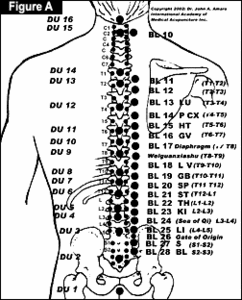The chiropractic profession has been recognized internationally throughout the medical and scientific community as the undisputed authority in the diagnosis and treatment of the vertebral subluxation complex.
There are probably few in the chiropractic profession who have more regard for the principle and practice of chiropractic than I have developed over my 35 years of practice. Even though, as a doctor, I am most often associated with the practice of acupuncture, I do practice chiropractic and adjust the vast majority of my patients as a stand-alone treatment or in addition to the administration of acupuncture.
Over chiropractic's 110-year history, there have been a variety of explanations of the spinal subluxation as the profession has evolved, ranging from the simple "vertebrae being out of place" to more contemporary findings describing the "dysfunctional vertebral motor unit" or "spinal fixation." There are a variety of manipulative and therapeutic applications specifically designed for and known to correct the subluxation.
 Without question, one of the most significant approaches to reducing a vertebral subluxation is a very simple procedure that employs the principle of acupuncture. Please bear in mind, acupuncture in this application is simply a "principle, not a technique"; it does not require the insertion of a needle, but simple transcutaneous electric nerve stimulation, gua sha (stroking application) or a combination of red and green lasers may be used with startling results. These techniques are available to any practitioner through physiotherapy modalities.
Without question, one of the most significant approaches to reducing a vertebral subluxation is a very simple procedure that employs the principle of acupuncture. Please bear in mind, acupuncture in this application is simply a "principle, not a technique"; it does not require the insertion of a needle, but simple transcutaneous electric nerve stimulation, gua sha (stroking application) or a combination of red and green lasers may be used with startling results. These techniques are available to any practitioner through physiotherapy modalities.
Any time a meridian has been determined to be dysfunctional or out of balance through electromeridian imaging (EMI), the meridian will always have a direct effect on its corresponding spinal shu or associated points, located two fingers breadth bilateral to the midline spinous process or governing vessel. Any imbalance of a meridian will in fact alter the dynamics of the tsang-fu or yin/yang organ function; it will likewise affect the musculoskeletal system, resulting in an aberration of motion and function affecting the specific vertebral level. Vertebral subluxations of this type are referred to as energetic subluxations of the vertebrae, whereby spinal fixation is created due to the hypertonic paraspinal musculature on one side of the vertebrae and the hypotonic musculature on the opposite side.
Once the DC determines through chiropractic evaluation which vertebrae are fixated, the practitioner, by examining figure A, will note that each vertebrae has two points - one on either side of the spinous process 0.5 tsun or half the breadth of the thumb. These points are classically known as the huatuojiaji points. These two points are simply needled for 10-15 minutes with a heavier stimulation on the hypertonic side of the vertebrae, simultaneously providing a lighter stimulation on the hypotonic side. In laser application, it is advised to utilize the red 5mw 635nm laser on the hypertonic side and utilize the 5mw 535mw green laser on the opposite laminae.
Beginning at C2 and not picking up again until between T1-T2, and coursing down the spine to include the sacrum, lies a combination of points known as the associated points, which are two fingers breadth bilateral to the spinous, all located on the bladder meridian. The other important points known as the governor vessel (du mo) are a series of points between the individual vertebrae.
It is this combination of acupuncture points that will have a dynamic effect on reducing an energetic subluxation complex, when stimulated after evaluation of either a chiropractic vertebral problem or a meridian imbalance through electromeridian imaging.
When one is utilizing noninvasive electronic stimulation, it is a simple matter of treating both huatuojiaji points of the involved vertebrae, plus the governing vessel and associated points if applicable. With gua sha, the practitioner, utilizing a lubricant oil, will stroke the vertebral levels with the bifurcated portion of the instrument over the involved vertebrae, striking the huatuojiaji points in addition to the governing vessel and associated (shu) points. Remember, the associated points are only illustrated on the right side of the body in figure A. They are bilateral in application.
What you will learn by simply studying the chart (figure A) will undoubtedly alter the way you, as a practitioner, approach and treat illness as it reflexes back to the spine, producing one of the most significant findings in the body, the vertebral subluxation.
Should you desire a full-page copy of this chart, please contact me with your request ( ).
Best wishes on your successful practice and the best to you in 2006, the year of the Fire Dog.
Click here for previous articles by John Amaro, LAc, DC, Dipl. Ac.(NCCAOM), Dipl.Med.Ac.(IAMA).





